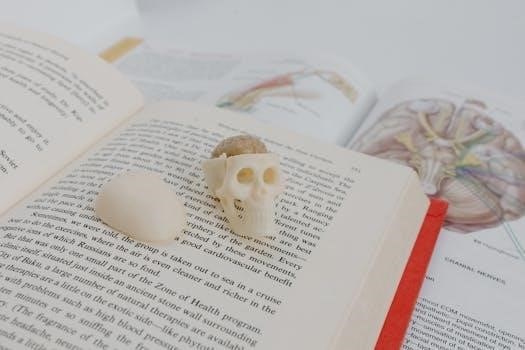Barlowe’s Guide to Fantasy: An Overview
Barlowe’s Guide to Fantasy, published in 1996, presents Wayne Barlowe’s artistic interpretations of iconic fantasy characters. Acting as a companion to his extraterrestrial guide, the book showcases a collection of creatures and heroes visualized with Barlowe’s signature style, offering readers a unique perspective.
The Book’s Premise and Scope
The book aims to visually realize beings previously confined to the imaginations of authors and readers. It features fifty full-color illustrations, bringing to life creatures from various fantasy and horror literary works with incredible accuracy and detail.
Visualizing Fantasy Literature
Barlowe’s Guide to Fantasy delves into the realm of visualizing fantasy literature by presenting Wayne Barlowe’s unique interpretations of famous characters and creatures. Before this book, many beings existed only in the minds of their creators and readers. Barlowe’s work bridges this gap, offering tangible, visual representations of these fantastic entities. The book acts as a guide, transporting readers into a world where imagination takes form, showcasing Barlowe’s artistic talent. It offers a new perspective on beloved stories, making the unseen, seen. This visualization enhances the experience, inviting readers to view fantasy literature through a different lens, enriching their understanding.

Wayne Barlowe: The Artist Behind the Guide
Wayne Barlowe, a celebrated figure in science fiction and fantasy art, is the creative force behind the Barlowe’s Guide to Fantasy. His detailed illustrations bring imaginative creatures to life, solidifying his reputation as a visionary artist.
Barlowe’s Background and Influences
Wayne Barlowe’s artistic journey includes creating images for books, films, and galleries, and writing novels. He attended Cooper Union and began his career painting paperback covers for major publishers. His extensive work in science fiction and fantasy shaped his artistic vision, leading to his unique style evident in the Barlowe’s Guide to Fantasy. His previous work on the Barlowe’s Guide to Extraterrestrials significantly influenced the creation of this later fantasy guide. Barlowe’s background in illustrating for various media ultimately led to him becoming known as the “Audubon of the Otherworld,” creating detailed depictions of imaginary creatures. His immersive style transports readers.
Contents of Barlowe’s Guide to Fantasy
The guide features over 50 color illustrations, meticulously bringing to life famous and beloved beings from fantasy literature. These visuals offer readers a unique insight into how Barlowe interprets iconic characters.
Featured Creatures and Characters
Barlowe’s Guide to Fantasy showcases a diverse array of creatures and characters drawn from the expansive realm of fantasy literature. Readers can expect to find Barlowe’s interpretations of figures like the Unicorn, imagined with shimmering detail inspired by Peter S. Beagle’s The Last Unicorn. The book presents a gallery of heroes, monsters, and mythical beings, each rendered with exquisite accuracy and detail.
From awe-inspiring heroes to disturbing monsters, the guide offers a visual feast for fantasy enthusiasts. Barlowe’s artistic vision brings these iconic figures to life, offering readers a fresh perspective on familiar faces and introducing them to new ones.

Connection to Barlowe’s Guide to Extraterrestrials
Barlowe’s Guide to Fantasy serves as a thematic sequel to Barlowe’s Guide to Extraterrestrials. While the first book explored alien life, this companion volume shifts focus to the realm of fantasy creatures and characters.
A Sequel’s Legacy
Following the success of Barlowe’s Guide to Extraterrestrials, which garnered awards and a second edition, Barlowe’s Guide to Fantasy emerged in 1996. As a sequel, it extends Barlowe’s unique approach to visualizing imaginative beings, transitioning from science fiction to fantasy literature. It offers a parallel exploration of imagined life, solidifying Barlowe’s reputation for breathing visual life into the extraordinary, much like its predecessor. The book’s impact lies in its ability to bridge the gap between written descriptions and vivid, tangible imagery, leaving a lasting impression on fantasy art and creature design.
Reception and Impact
Barlowe’s Guide to Fantasy received positive reception for its artistic interpretations and imaginative creature designs. The book has become a source of inspiration, influencing artists and fantasy enthusiasts alike with its unique visualizations.
Critical Acclaim and Reader Response
Barlowe’s Guide to Fantasy garnered critical acclaim for Wayne Barlowe’s stunning artwork and unique interpretations of fantasy creatures. Many readers express that the book is a masterpiece, praising its ability to transport them to new worlds. Some have described the book as a source of inspiration, igniting their imagination and offering endless hours of entertainment. The guide has been lauded for bringing to life characters previously only seen in the minds of creators and readers, offering a visual representation of beloved fantasy figures. The book’s impact is evident in its continued popularity and influence on fantasy art.

The Textual Component
Neil Duskis provided the interior text for Barlowe’s Guide to Fantasy. The textual component complements Barlowe’s illustrations, offering insights into the creatures and characters featured, enhancing the reader’s experience and understanding of the fantasy worlds.
Neil Duskis’s Contribution
Neil Duskis played a crucial role in shaping Barlowe’s Guide to Fantasy through his contributions to the book’s textual content. While Wayne Barlowe’s illustrations brought the creatures and characters to life visually, Duskis provided the accompanying descriptions and background information that enriched the reader’s understanding of each subject. His words offered insights into the origins, characteristics, and significance of the featured beings, enhancing the overall immersive experience. Duskis’s writing served as a valuable complement to Barlowe’s artwork, creating a comprehensive and engaging guide to the realms of fantasy. He provided context, lore, and depth to the fantastical figures.
Illustrative Style and Detail
Barlowe’s illustrations in the guide are known for their exquisite detail and realism, bringing fantasy creatures to life. His style captures the imagination, rendering each being with accuracy and a unique artistic vision.
Barlowe’s Artistic Techniques
Wayne Barlowe’s artistic techniques within Barlowe’s Guide to Fantasy demonstrate his mastery of detail and realism, bringing fantastical beings to life with remarkable accuracy. His approach involves meticulously crafted renderings, using color and shading to create depth and texture. Each illustration showcases Barlowe’s ability to capture the essence of the characters, blending imagination with anatomical precision. He effectively uses light and shadow to highlight the unique features of each creature, emphasizing their otherworldly characteristics. Barlowe’s techniques transport the viewer into the realm of fantasy, providing a vivid and immersive experience, solidifying his reputation as a visionary artist. This attention to detail sets his work apart.

Editions and Availability
Barlowe’s Guide to Fantasy, originally published by HarperPrism, can still be found today. Copies are available through online retailers and used bookstores. First editions are sought after by collectors for their rarity and value.
Finding the Book Today
Despite being published in 1996, Barlowe’s Guide to Fantasy remains accessible to enthusiasts and collectors. Online marketplaces like Amazon and eBay frequently list both new and used copies, with prices varying based on condition and edition. Collectors often seek out first editions and well-preserved copies.
Used bookstores and library sales also offer potential avenues for discovering the book. Digital versions or reprints might be available through various online platforms, broadening access for modern readers. Its enduring appeal ensures continued availability for those seeking Barlowe’s unique artistic vision of fantasy worlds, even decades after its initial release.
Influence on Fantasy Art and Literature
Barlowe’s Guide to Fantasy has inspired many artists and writers. Its detailed creature designs and imaginative interpretations have shaped the visual landscape of fantasy, influencing subsequent generations in both art and literature.
Inspiring New Creations
Barlowe’s Guide to Fantasy serves as a rich source of inspiration for new fantasy creations. By providing tangible visualizations of mythical beings, Barlowe’s work empowers artists and writers to develop their own unique characters and worlds. The book’s impact extends to various media, including film, gaming, and illustration, where its designs have been adapted and re-imagined; It encourages a deeper exploration of fantasy archetypes, fostering innovation within the genre. The guide sparks creativity, leading to fresh interpretations of familiar concepts and the birth of entirely original creatures and narratives that push the boundaries of fantasy storytelling.




















